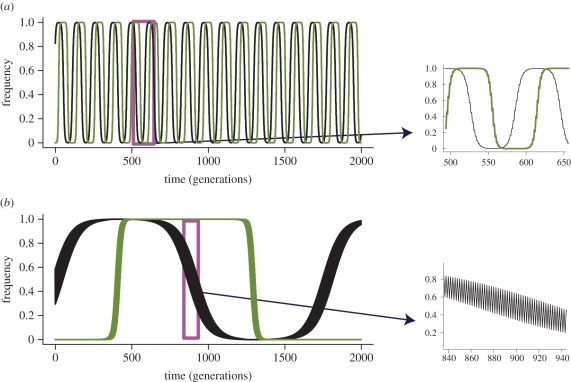Figure 2.
Impact of the rapidly changing environment on host–parasite coevolutionary dynamics with MA interactions. Both panels show the simulation results of the model. (a) Rapid RQ dynamics in spite of comparatively weak selection. (b) Slow RQ dynamics in spite of comparatively strong selection. Allele-frequency changes proceed faster in (a) than in (b) because the long term, average selection acting on the population (effective selection) in (a) is stronger than such long-term selection in (b). In both panels, subplots show rapid allele fluctuations from one generation to another caused by rapidly altering direction of selection. Importantly, in both panels, the condition  is fulfilled; its violation would lead to a permanent synergistic interaction, and hence allele fixation. Values used in (a) are sHE1 = 0.4, sPE1 = 0.6, sHE2 = 0.01, sPE2 = 0.1, and values used in (b) are sHE1 = 0.71, sPE1 = 0.95, sHE2 = 0.7, sPE2 = 0.94. All simulations use T = 2 (environment not shown). Black lines, host A; green lines, parasite A.
is fulfilled; its violation would lead to a permanent synergistic interaction, and hence allele fixation. Values used in (a) are sHE1 = 0.4, sPE1 = 0.6, sHE2 = 0.01, sPE2 = 0.1, and values used in (b) are sHE1 = 0.71, sPE1 = 0.95, sHE2 = 0.7, sPE2 = 0.94. All simulations use T = 2 (environment not shown). Black lines, host A; green lines, parasite A.

